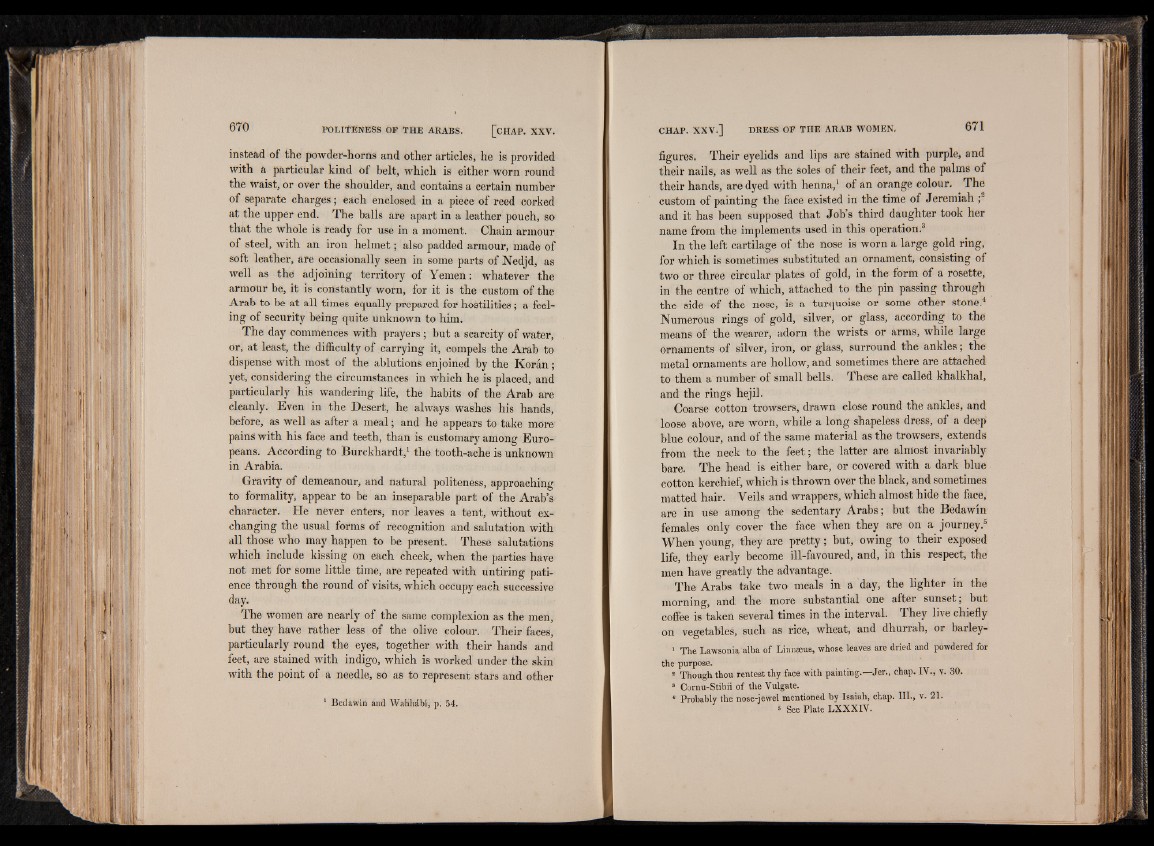
instead of the powder-horns and other articles, he is provided
with a particular kind of belt, which is either worn round
the Waist, or over the shoulder, and contains a certain number
of separate charges; each enclosed in a piece of reed corked
at the upper end. The halls are apart in a leather pouch, so
that the whole is ready for use in a moment. Chain armour
of steel, with an iron helmet; also padded armour, made of
soft leather, are occasionally seen in some parts of Nedjd, as
well as the adjoining territory of Yemen: whatever the
armour be, it is constantly worn, for it is the custom of the
Arab to be at all times equally prepared for hostilities; a feeling
of security being quite unknown to him.
The day commences with prayers; but a scarcity of water,
or, at least, the difficulty of carrying it, compels the Arab to
dispense with most of the ablutions enjoined by the Koran;
yet, considering the circumstances in which he is placed, and
particularly his wandering life, the habits of the Arab are
cleanly. Even in the Desert, he always washes his hands,
before, as well as after a meal; and he appears to take more
painS with his face and teeth, than is customary among Europeans.
According to Burckhardt,1 the. tooth-ache is unknown
in Arabia.
Gravity of demeanour, and natural politeness, approaching
to formality, appear to be an inseparable part of the Arab’s
character. He never enters, nor leaves a tent, without exchanging
the usual forms of recognition and salutation with
all those who may happen to be present. These salutations
which include kissing on each cheek, when the parties have
not met for some little time, are repeated with untiring patience
through the round of visits, which occupy each successive
day.
The women are nearly of the same complexion as the men,
but they have rather less of the olive colour. Their faces,
particularly round the eyes, together with their hands and
feet, are stained with indigo, which is worked under the shin
with the point of a needle, so as to represent stars and other
figures. Their eyelids and lips are stained with purple, and
their nails, as well as the soles of their feet, and the palms of
their hands, are dyed with henna,1 of an orange colour. The
custom of painting the face existed in the time of Jeremiah ;2
and it has been supposed that Job’s third daughter took her
name from the implements used in this operation.3
In the left cartilage of the nose is worn a large gold ring,
for which is sometimes substituted an ornament, consisting of
two or three circular plates of gold, in the form of a rosette,
in the centre of which, attached to the pin passing through
the side of the nose, is a turquoise or some other stone.4
Numerous rings of gold, silver, or glass, according to the
means of the wearer, adorn the wrists or arms, while large
ornaments of silver, iron, or glass, surround the ankles; the
metal ornaments are hollow, and sometimes there are attached
to them a number of small bells. These are called khalkhal,
and the rings hejil.
Coarse cotton trowsers, drawn close round the ankles, and
loose above, are worn, while a long shapeless dress, of a deep
blue colour, and of the same material as the trowsers, extends
from the neck to the feet; the latter are almost invariably
bare, The head is either bare, or covered with a dark blue
cotton kerchief, which is thrown over the black, and sometimes
matted hair. Veils and wrappers, which almost hide the face,
are in use among the sedentary Arabs; but the Bedawin
females only cover the face when they are on a journey.5
When young, they are pretty; but, owing to their exposed
life, they early become ill-favoured, and, in this respect, the
men have greatly the advantage.
The Arabs take two meals in a day, the lighter in the
morning, and the more substantial one after sunset, but
coffee is taken several times in the interval. They live chiefly
on vegetables, such as rice, wheat, and dhurrah, or barley-
1 The Lawsonia alba of Linnaeus, whose leaves are dried and powdered for
the purpose.
3 Though thou rentest thy face with painting.—Jer., chap. IV., v. 30.
3 Comu-Stibii of the Vulgate.
* Probably the nose-jewel mentioned by Isaiah, chap. III., v. 21.
3 See Plate LXXXIV.